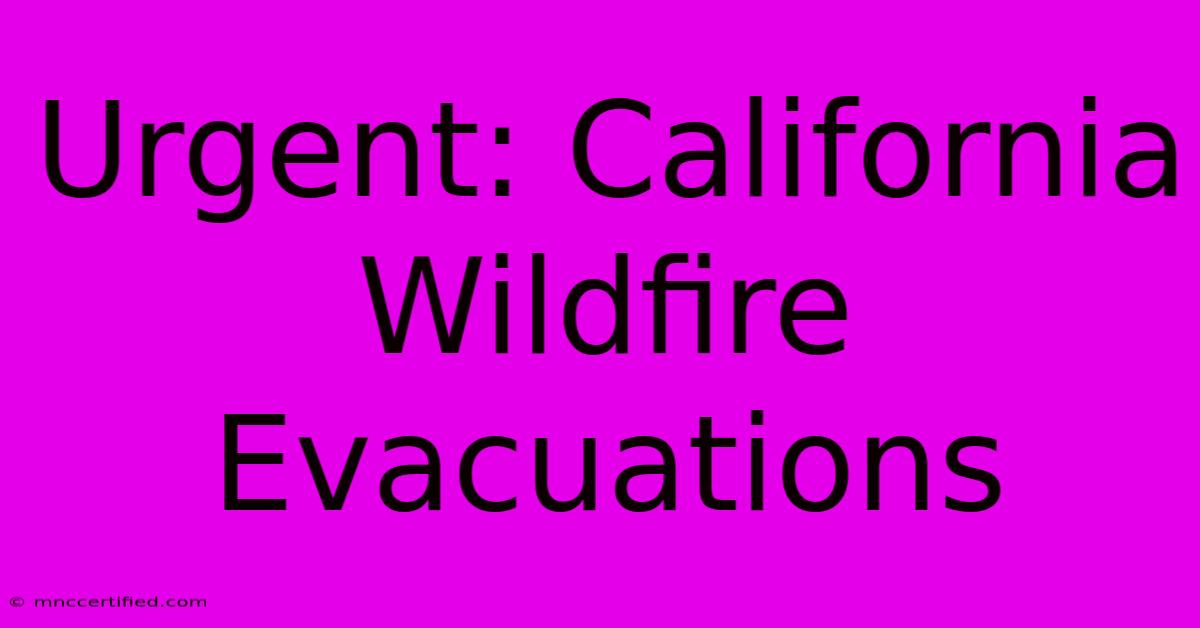Urgent: California Wildfire Evacuations

Table of Contents
Urgent: California Wildfire Evacuations: A Guide to Safety and Preparedness
California wildfires are a devastating reality, striking with terrifying speed and leaving communities scrambling for safety. This article provides crucial information on how to prepare for, react to, and recover from wildfire evacuations in California. We'll cover everything from creating an evacuation plan to understanding the resources available to you.
Understanding the Threat: California's Wildfire Season
California's wildfire season, traditionally spanning late summer and fall, is becoming increasingly unpredictable and longer due to climate change. Hotter, drier conditions fuel faster-spreading and more intense fires. Understanding the risks specific to your area is the first step in effective preparedness. Check your local fire department's website for risk assessments and alerts. Familiarize yourself with common wildfire indicators, such as unusual smoke, rapidly spreading flames, or strong, shifting winds.
High-Risk Areas in California:
California has numerous areas particularly vulnerable to wildfires. These include, but aren't limited to:
- Southern California: Areas like San Diego County, Los Angeles County, and Ventura County are frequently impacted.
- Northern California: The Sierra Nevada foothills, Napa Valley, and Sonoma County face significant risks.
- Central California: Areas with chaparral vegetation are especially susceptible.
Knowing your community's risk level allows you to prioritize preparedness efforts.
Creating Your Wildfire Evacuation Plan: A Step-by-Step Guide
A well-defined evacuation plan is crucial. Don't wait until the last minute; proactive preparation saves lives.
1. Identify Evacuation Routes:
- Multiple routes: Plan at least two different evacuation routes, considering potential road closures.
- Route familiarity: Regularly practice driving these routes to become familiar with them.
- Alternative destinations: Identify safe locations outside the affected area where you can stay with family, friends, or in pre-booked accommodations.
2. Assemble Your Go-Bag:
Your go-bag is your lifeline. It should include:
- Important documents: Copies of identification, insurance policies, medical records, and financial information.
- Essential medications: A sufficient supply for several days.
- First-aid kit: Including bandages, antiseptic wipes, and pain relievers.
- Water and non-perishable food: Enough for at least 72 hours.
- Clothing and footwear: Comfortable, sturdy shoes are crucial.
- Cash: ATMs may be inaccessible during emergencies.
- Flashlight and batteries: For navigating in the dark.
- Cell phone charger: A portable power bank is highly recommended.
- Pet supplies: Food, water, leash, carrier, and medical records for your pets.
3. Develop a Communication Plan:
Designate a meeting point outside the evacuation zone and establish a method for contacting family members. This could involve a pre-arranged text message chain or a designated out-of-state contact.
4. Stay Informed:
Monitor weather reports, local news, and official emergency alerts. Sign up for emergency alerts through your local government's website or mobile app. CAL FIRE and the National Weather Service are valuable resources.
During a Wildfire Evacuation:
- Heed evacuation warnings immediately. Do not wait for a mandatory order.
- Secure your home: Close windows and doors, turn off gas appliances, and bring in loose outdoor items.
- Follow designated evacuation routes. Avoid congested areas.
- Stay aware of your surroundings. Be alert for falling debris and hazards.
- Drive carefully. Be aware of smoke and reduced visibility.
- Check on vulnerable neighbors: Assist elderly or disabled individuals with their evacuation.
After the Wildfire:
- Contact local authorities: Check for road closures and safety updates.
- Assess property damage: Do so carefully, avoiding hazardous areas.
- Seek assistance: Utilize available resources for housing, financial aid, and emotional support. The Red Cross offers crucial support.
- Document damages: Take photos or videos as evidence for insurance claims.
Keywords for SEO:
California wildfires, wildfire evacuation, evacuation plan, wildfire safety, California fire safety, emergency preparedness, wildfire resources, go-bag checklist, emergency kit, CAL FIRE, National Weather Service, Red Cross, wildfire evacuation routes, wildfire prevention, fire safety tips, natural disaster preparedness, California emergency services.
By following these guidelines and staying informed, you can significantly improve your safety and preparedness during California wildfire evacuations. Remember, preparation is key. Don't wait until it's too late.

Thank you for visiting our website wich cover about Urgent: California Wildfire Evacuations. We hope the information provided has been useful to you. Feel free to contact us if you have any questions or need further assistance. See you next time and dont miss to bookmark.
Featured Posts
-
Pachuca Vs Real Madrid 0 3 Fifa Recap
Dec 19, 2024
-
Key House Panel Releases Gaetz Report
Dec 19, 2024
-
600 M Adidas Deal For Lillard
Dec 19, 2024
-
Soto Fire Update 80 Containment
Dec 19, 2024
-
Eddie Stobart Founder Passes Away
Dec 19, 2024